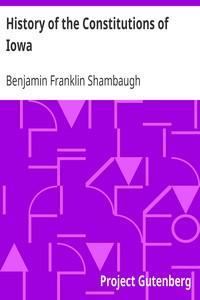Read this ebook for free! No credit card needed, absolutely nothing to pay.
Words: 12974 in 4 pages
This is an ebook sharing website. You can read the uploaded ebooks for free here. No credit cards needed, nothing to pay. If you want to own a digital copy of the ebook, or want to read offline with your favorite ebook-reader, then you can choose to buy and download the ebook.


: History of the Constitutions of Iowa by Shambaugh Benjamin Franklin - Constitutions Iowa; Constitutional history Iowa
The boundary question now led a considerable number of the more moderate Democrats to oppose ratification. Prominent leaders of the party took the stump and declared that it would be better to reject the Constitution altogether than to accept the limited boundaries proposed by Congress. They declared that the "natural boundaries" as prescribed by the Constitution should not be curtailed, and called upon all good Democrats to vote down their own Constitution. Many, however, continued to support ratification, believing that the boundaries imposed by the act of Congress were the best that could be obtained under the existing conditions. Augustus Dodge, the Iowa Delegate in Congress, took this stand.
From the returns of the election it was evident that Mr. Dodge's constituents either did not take him seriously or were sure that he was mistaken in his conclusions. The Constitution of 1844 was rejected by a majority of 996 votes.
The result of the election was such as to "astound the friends of the Constitution and to surprise everybody, both friend and foe." Those who had labored for ratification throughout the campaign abused the Whigs for opposing so perfect an instrument, censured the Convention for submitting the Constitution to Congress before it had been ratified by the people, and preferred general charges of misrepresentation. The friends of the Constitution clamored loudly for a resubmission of the code of fundamental law as it had come from the Convention, so that the people might have an opportunity to pass upon it free from conditions and without misrepresentation. Within a few weeks the seventh Legislative Assembly of the Territory was to meet in regular session. The members would be asked to give the Constitution of 1844 another chance.
THE CONSTITUTION OF 1844 REJECTED A SECOND TIME
On Monday the fifth day of May, 1845, the Legislative Assembly of the Territory met in regular session. Three days later a message from Governor Chambers was presented and read to the members, whereby they were informed that the vote in April had certainly resulted in the rejection of the Constitution. "And," continued the Governor, "there is reason to believe that the boundary offered us by Congress had much influence in producing that result."
Believing that the rejection of the Constitution by the people called for some action on the part of the Assembly, Governor Chambers proposed and recommended "that the question be again submitted to the people, whether or not they will at this time have a Convention." But a majority of the Assembly were in favor of re-submitting the Constitution of 1844 as it had come from the hands of the Convention. A bill to re-submit was accordingly introduced and hurried through to its final passage.
Although the bill for re-submission had passed both branches of the Assembly by a safe majority, Governor Chambers did not hesitate to withhold his assent. On June 6 he returned it to the Council. But it is difficult to ascertain the precise grounds upon which the Governor withheld his approval, since his message deals with conditions rather than objections. In the first place he reviewed the conditions under which the Constitution of 1844 had at the same time been submitted to Congress and to the people of the Territory. Then he pointed out that, whereas a poll was taken on the Constitution according to law, no provision had been made for a separate poll on the conditions imposed by Congress. This, he thought, produced such confusion in the public mind as to cause the defeat of the Constitution. To be sure, he had proposed and was still in favor of submitting the question of a Convention to the people. But he would not now insist on such a policy. He freely admitted that the Legislative Assembly had the power to pass the measure before him. At the same time it seemed to him that, should the Constitution of 1844 be re-submitted to the people, it would simply give rise to confusion in attempts to reconcile and harmonize the various provisions of the statutes of the Territory, the act of Congress, and the Constitution.
Thus the people were again asked to pass upon the Constitution of 1844. The campaign of the summer of 1845 was very much like the campaign of the spring. All of the leading arguments both for and against the Constitution were repeated in the press and on the stump. The parties divided on the same lines as before, except that the Whigs in their opposition had the assistance of a much larger Democratic contingent.
One is surprised to find, in connection with the boundary question, little or no mention of "slavery," the "balance of power," or the "small State policy." Indeed the people of Iowa seemed wholly indifferent to these larger problems of National Politics. It is perhaps the most remarkable fact in the fascinating history of the Constitution of 1844 that, in the dispute over boundaries, the parties did not join issue on common grounds. Congress, on the one hand, desired to curtail the boundaries of Iowa for the purpose of creating a greater number of Northern States to balance the slave States of the South; whereas the people of Iowa protested against such curtailment not because of any balance-of-power considerations, but simply because they wanted a large State which would embrace the fertile regions of the Missouri on the West and of the St. Peters on the North.
These charges were not without foundation; for the records of Congress show that in May, 1846, the Speaker of the House of Representatives "presented a memorial of the citizens of the Territory of Iowa north of the forty-second degree of north latitude, praying for the establishment of a new territorial government, extending from the Mississippi river between the parallel of forty-two degrees and the northern boundary line of the United States. Also a memorial of Thomas McKnight and others, citizens of Dubuque county, in said Territory of like import."
THE CONVENTION OF 1846
When the members of the eighth Legislative Assembly of the Territory of Iowa met in the Capitol on the first Monday of December, 1845, they found that, as a result of the rejection of the Constitution of 1844, they were face to face with the question which for six years had confronted the pioneer law-makers of Iowa as the greatest political issue of the Territorial period. They found that the whole problem of State organization was before them for reconsideration.
Free books android app tbrJar TBR JAR Read Free books online gutenberg
More posts by @FreeBooks

: The Coming of Evolution: The Story of a Great Revolution in Science by Judd John W John Wesley - Evolution (Biology) History


: Charles Sumner Centenary: Historical Address The American Negro Academy. Occasional Papers No. 14 by Grimk Archibald Henry - Sumner Charles 1811-1874





